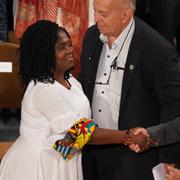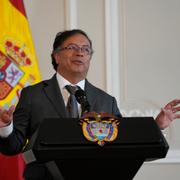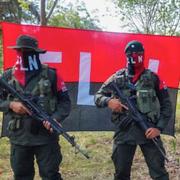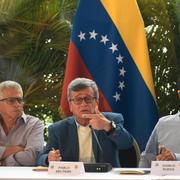
Farc-ledare bombad till döds av militären
En grupp på tio Farc-rebeller dödades i en bombning som colombiansk militär utförde i Caquetaprovinsen i veckan. Det uppger försvarsminister Diego Molano på fredagen, enligt Reuters.
Bland dem fanns enligt ministern Nestor Gregorio Vera, känd under namnet Ivan Mordisco och en av ledarna för de utbrytargrupper som inte accepterar Farc-gerillans fredsavtal med den colombianska regeringen.
Flera högt uppsatta ledare för stridande Farc-fraktioner har dödats av militären i Colombia och Venezuela under den senaste tiden.

Polisens bevis för att Vera dödats: hans telefon, dator, basker och båt hittades på platsen för bombningen (spanska)
bakgrund
Revolutionary Armed Forces of Colombia
Wikipedia (en)
The Revolutionary Armed Forces of Colombia—People's Army (Spanish: Fuerzas Armadas Revolucionarias de Colombia—Ejército del Pueblo, FARC–EP or FARC) is a Marxist–Leninist guerrilla group involved in the continuing Colombian conflict starting in 1964. The FARC–EP was formed during the Cold War period as a peasant force promoting a political line of agrarianism and anti-imperialism. They are known to employ a variety of military tactics, in addition to more unconventional methods, including terrorism.The operations of the FARC–EP were funded by kidnap and ransom, illegal mining, extortion, and taxation of various forms of economic activity, and the production and distribution of illegal drugs. They are only one actor in a complex conflict where atrocities have been committed by the state, right-wing paramilitaries, and left-wing guerrillas not limited to FARC, such as ELN, M-19, and others. Colombia's National Centre for Historical Memory, a government agency, has estimated that between 1981 and 2012 paramilitary groups have caused 38.4% of the civilian deaths, while the Guerillas are responsible for 16.8%, 27.7% by non-identified armed groups, and 10.1% by the Colombian Security Forces. The National Centre for Historical Memory has also concluded that of the 27,023 kidnappings carried out between 1970 and 2010, the Guerillas were responsible for 90.6% of them. The United Nations has estimated that 12% of all civilian deaths in the Colombian conflict were caused by FARC and National Liberation Army (ELN) guerrillas, with 80% caused by right-wing paramilitaries, and the remaining 8% caused by Colombian security forces.The strength of the FARC–EP forces was high; in 2007, the FARC said they were an armed force of 18,000 men and women; in 2010, the Colombian military calculated that FARC forces consisted of about 13,800 members, 50 percent of whom were armed guerrilla combatants; and in 2011 the president of Colombia, Juan Manuel Santos, said that FARC–EP forces comprised fewer than 10,000 members. The Colombian Ministry of Defense reported 19,504 deserters, or individually demobilized members, from the FARC between August 2002 and their collective demobilization in 2017, despite potentially severe punishment, including execution, for attempted desertion in the FARC.In 2012, the FARC made 239 attacks on the energy infrastructure; however, they showed signs of fatigue. By 2014, the FARC were not seeking to engage in outright combat with the army, instead concentrating on small-scale ambushes against isolated army units. Meanwhile, from 2008 to 2017, the FARC opted to attack police patrols with home-made mortars, sniper rifles, and explosives, as they were not considered strong enough to engage police units directly. This followed the trend of the 1990s during the strengthening of Colombian government forces.In June 2016, the FARC signed a ceasefire accord with the President of Colombia, Juan Manuel Santos in Havana. This accord was seen as an historic step to ending the war that has gone on for fifty years. On 25 August 2016, the Colombian president, Juan Manuel Santos, announced that four years of negotiation had secured a peace deal with FARC and that a national referendum would take place on 2 October. The referendum failed with 50.24% voting against. On November 24, 2016, the Colombian government and the FARC signed a revised peace deal, which the Colombian Congress approved on 30 November.On 27 June 2017, FARC ceased to be an armed group, disarming itself and handing over its weapons to the United Nations. One month later, FARC announced its reformation as a legal political party, in accordance with the terms of the peace deal. However, about 2,000 to 2,500 FARC dissidents still take on FARC's original doctrine and continue with drug trafficking, though far smaller than the group at its peak.A small faction of FARC leaders announced a return to armed activity on 29 August 2019, stating that the Colombian government did not respect peace agreements, a position Colombian officials disagreed with. The Colombian government responded with offensive strikes, killing FARC members planning to lead rearmament activities.
Caqueta
Omni är politiskt obundna och oberoende. Vi strävar efter att ge fler perspektiv på nyheterna. Har du frågor eller synpunkter kring vår rapportering? Kontakta redaktionen



